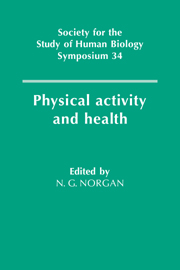Book contents
- Frontmatter
- Contents
- List of contributors
- Acknowledgements
- 1 Introduction
- 2 Comparative aspects of human activity
- 3 Physical activity levels – past and present
- 4 The validity of health measurements
- 5 Developments in the assessment of physical activity
- 6 Two national surveys of activity, fitness and health: the Allied Dunbar National Fitness survey and the Welsh Heart Health survey
- 7 Physical development and childhood activity
- 8 Physical activity and behavioural development during childhood and youth
- 9 Physiological aspects of activity and ageing
- 10 Activity and morale in later life: preliminary analysis from the Nottingham Longitudinal Study of Activity and Ageing
- 11 The benefits of low intensity exercise
- 12 Physical activity, obesity and weight maintenance
- 13 Adherence to physical activity and exercise
- 14 Women's working behaviour and maternal-child health in rural Nepal
- 15 Physical activity and psychological well-being
- 16 Leisure lifestyles: present and future
- Index
14 - Women's working behaviour and maternal-child health in rural Nepal
Published online by Cambridge University Press: 05 December 2011
- Frontmatter
- Contents
- List of contributors
- Acknowledgements
- 1 Introduction
- 2 Comparative aspects of human activity
- 3 Physical activity levels – past and present
- 4 The validity of health measurements
- 5 Developments in the assessment of physical activity
- 6 Two national surveys of activity, fitness and health: the Allied Dunbar National Fitness survey and the Welsh Heart Health survey
- 7 Physical development and childhood activity
- 8 Physical activity and behavioural development during childhood and youth
- 9 Physiological aspects of activity and ageing
- 10 Activity and morale in later life: preliminary analysis from the Nottingham Longitudinal Study of Activity and Ageing
- 11 The benefits of low intensity exercise
- 12 Physical activity, obesity and weight maintenance
- 13 Adherence to physical activity and exercise
- 14 Women's working behaviour and maternal-child health in rural Nepal
- 15 Physical activity and psychological well-being
- 16 Leisure lifestyles: present and future
- Index
Summary
Introduction
There continues to be a great deal of concern for the health of women and young children in rural third-world communities where sustained physical effort is a mandatory way of life. Mothers and children were identified as vulnerable population groups when it was realized that rural women do not necessarily improve their diet or substantially reduce their work-loads during childbearing, and that children of working mothers may experience low birth weight and reduced levels of care. This situation has raised two important areas of inquiry. First, debate has centred on the ways in which women on tight energy budgets manage to cope with repeated reproductive demands (Rajalaksmi, 1980; Prentice, 1984; Durnin, 1985; Durnin & Drummond, 1988; Ferro-Luzzi, 1988). Secondly, the potential conflict between a woman's economic and childcare activities has been highlighted (Leslie, 1988; Hill & Kaplan, 1988), prompting investigation of the cost at which mothers, with little time and energy to spare, combine both responsibilities.
A focus on women's actual behaviour is important to such an inquiry. Whenever possible, women can be expected to minimize their work-loads; in Amazonia for instance, Ache mothers reduce their subsistence activity once children are born, in order to focus on infant care (Hurtado et al., 1985). Yet women may not always be able to curtail their economic activities: they will tend to decrease optional tasks rather than essential economic work.
- Type
- Chapter
- Information
- Physical Activity and Health , pp. 190 - 206Publisher: Cambridge University PressPrint publication year: 1992
- 6
- Cited by



